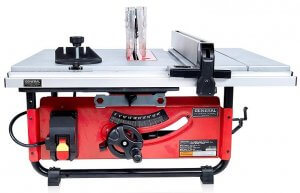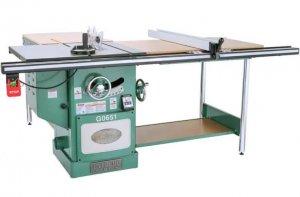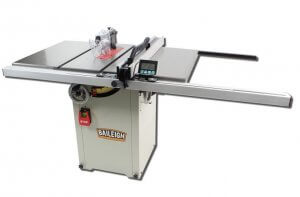Whether you’re a woodworking hobbyist or a professional contractor, you probably either have a table saw or you’re considering purchasing one.
If you’re a home hobbyist, a table saw will allow you to rip longer stock, make repeatable cuts, work more quickly, create edges, and take projects to the next level. If you’re a carpenter or in construction by trade, having a reliable table saw is a must.
But before you can determine what brand and model is right for you, you’ve first got to determine what type of table saw you need.
Table saws can be divided into four categories:
- Benchtop
- Contractor
- Cabinet
- Hybrid
Each of these types of table saws are designed for different applications and job conditions. There’s also a vast range in prices, starting at around $200 and going upwards of $5,000. We’ll explain the different types available, discuss their pros and cons, and share our opinion on which type of saw is best for each type of application.
Benchtop Table Saws

Saws in this category are great for ripping, and though you can do detailed work with this equipment, you won’t necessarily get the highest tolerances. It’s not the best choice for high-end work and finished cabinetry work as most models in this category aren’t accurate enough for fine woodworking. Another limitation to consider is that the table is going to be narrower than saws in other categories. This limits the width of lumber that can be ripped. The narrow surface can also make crosscuts more difficult.
Because they have a universal motor, they’re also the least powerful. You’re probably not going to have enough power to rip hardwood or thicker soft woods, and the motor itself is going to be louder by several decibels. However, if you need a table saw on a job site for basic cuts and less precise edges, these saws should perform adequately.
These saws aren’t designed to last forever, though you can reasonably expect to get several years out of them. They’re also the least expensive in this category. If you’re short on space, you want to get started quickly, and you’re operating on a budget, a portable benchtop table saw is your best choice.
What they’re designed for: Ripping light lumber, quick cuts, routine carpentry tasks
Who they’re designed for: Carpenters, home hobbyists with limited space, contractors on job sites who need a lightweight saw
Key features: Lightweight, portable, easy assembly, inexpensive
Typical price range: Between $199 and $1,299
Contractor Table Saws
Contractor table saws are also referred to as open-stand saws. Considered a step up from the benchtop variety, they’re heavier and more durable, and they tend to have larger tables. They’re considered semi-portable, and some models will have wheels.
One of the most significant differentiators between a contractor table saw and a benchtop model has to do with the motor. Contractor saws have induction motors, which are larger, belt-driven, and more powerful. The table will also be a heavier material, typically cast-iron, though the side tables may still be a lighter-weight stamped metal. If the side tables are cast iron, expect them to be “open webbed.”
A contractor saw will have heavier duty trunnions, making the unit more durable while also enabling it to cut heavier stock. These saws also tend to hold adjustment settings longer due to this added stability. Despite the added weight, these saws are classified as “semi-portable,” weighing in between 250 and 350 pounds. To encourage mobility, the motor may hang off of the back of the saw, which allows it to be removed for transport.
Contractor saws are becoming less common as many contractors are making the switch to jobsite saws, especially as the portable jobsite saws are becoming more advanced and durable. This trend has become especially noticeable within the last five years. Still, they’re able to cut thicker stock, though they do require more space and they cost a little bit more. They also have an upgraded fence, ensuring quality and accuracy of the cuts, and making the apparatus more enjoyable to use as a whole. You can also expect a better miter gage with little to no slop when you adjust it, again, allowing for more precision.
To sum up, these units are larger, more powerful and more durable, though they tend to be costlier. Dust collection can be an issue if you don’t have a dedicated dust collection system.
What they’re designed for: Carpenter work, small cabinetry projects, basic furniture making, trim work
Who they’re designed for: Contractors who want something durable that they can still move between jobsites, hobbyists and contractors who want better performance at an affordable price.
Key features: Induction motor (1-2 horsepower), larger table, heavy duty, ability to cut thicker stock, high quality and still somewhat portable
Typical price range: From $500 to $1,700
Cabinet Table Saws
Also referred to as shop saws, cabinet table saws get their name because the base is a fully enclosed cabinet. These units are designed with the professional woodworker in mind. Woodworkers who want both their equipment and their work to last forever are best suited for a cabinet table saw.
These saws enable tight cuts and low tolerances. The motors range from 3 to 5 horsepower and the base is generally wired to a 220-volt circuit. Once you decide where to put your cabinet saw, don’t plan on moving it any time soon. These units are wired, not plugged in to the wall. Plus, they weigh 600 pounds or more.
The large sturdy table guarantees a flat surface, and though you’re going to pay substantially more for a cabinet saw, you can expect superior performance.
Having the motor mounted inside the cabinet makes it quieter, and the enclosed base also makes dust collection a simple, streamlined process. There’s also going to be a height and tilt adjustment feature, providing the user with an ergonomic experience.
Every component on these saws is heavy duty and built for performance. The controls are smooth, there’s no slop, and it’ll devour anything it comes into contact with. The rip fence in this category of saw is finely tuned and can easily produce cuts with the tolerance of 1/32 inch, which is necessary in fine woodworking.
This saw is sometimes referred to as an heirloom saw. It is built not just to last for one lifetime, but for generations to come. Just make sure you know how to use it safely.
What they’re designed for: Precise cuts, high-end cabinet work
Who they’re designed for: Professional woodworkers, serious hobbyists
Key features: Fully enclosed base, smooth controls, powerful motor (3-5 horsepower), built to last a lifetime (or longer)
Typical price range: $2,000 – $5,000
Hybrid Table Saws
A hybrid table saw is a cross between a contractor’s saw and a cabinet saw. It contains many of the features and characteristics of a cabinet saw, but it’s more compact. Often, it looks like a cabinet saw, but has the functionality of the contractor version. These saws are gaining in popularity because they perform similarly to cabinet saws, but they have a substantially lower price tag.
One can expect heavy-duty parts and high performance with a hybrid. In reality, it’s considered a scaled-down version of the cabinet version. It’s lighter weight and modern models can often run on either a 110 or 220v. However, most are wired for 110 volts, which can be a plus for convenience.
These units boast heavy-duty trunnions that can be mounted on the case itself instead of the table, allowing for easier adjustments. The fence is also going to be a major step up from the contractor varieties. These saws tend to run on 2 horsepower (sometimes 1.75), while the professional cabinet versions are 3 to 5. Depending on how serious you are, this may be enough of a difference for you want to want to upgrade.
What they’re designed for: Suitable for most woodworking projects
Who they’re designed for: Serious hobbyists who don’t necessarily need the power or want the expense of a cabinet saw but still want accuracy, stability, and reliability
Key features: Powerful motor, heavy-duty components, 110 or 220v, offers precision cuts and smooth controls
Typical price range: $900 – $2,400
Conclusion
There are several factors to consider when deciding which type of table saw is best suited for your needs, including:
- Budget: How much you want to spend
- Precision: How precise or accurate you need your cuts to be
- Application: Whether you’re doing detailed work or simply ripping lumber
- Job Size: Whether the saw will be used for large projects or an infrequent cut
- Portability: Does the unit need to be moved from site to site? Does it need to be transported from the garage to the driveway?
- Placement: How much room is available, and whether the unit will ever need to be moved.
- Power: Do you need a powerful motor? Or can you get by with less?
- Skill level and passion: Are you a casual hobbyist or do you plan on using this device on an everyday basis with the hope of keeping it in the family for generations?
Once you determine your budget and overall needs, you’ll have a clear idea of which category of table saw is best for your situation. There’s no single right answer; however, price is often one of the first considerations among hobbyists and professionals alike. We encourage you to first evaluate your needs and then look for a unit that fits within your budget.



Reader Interactions